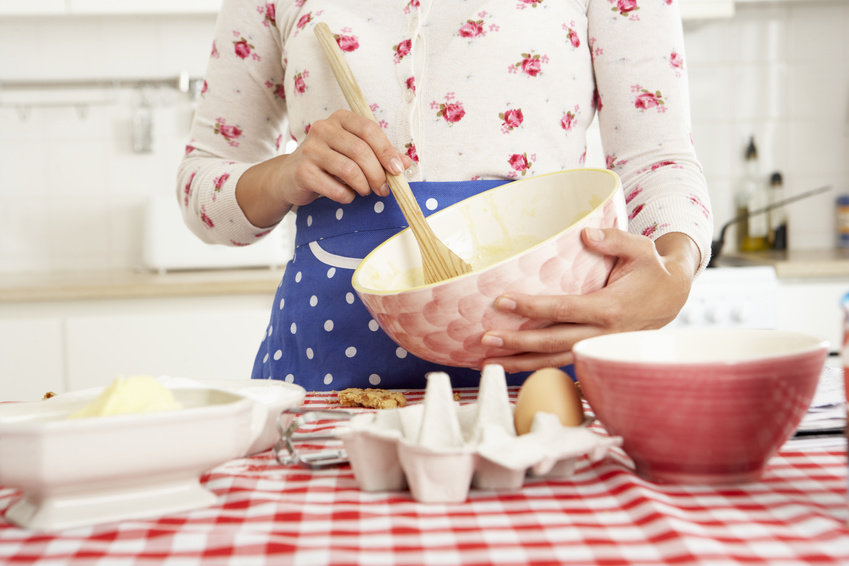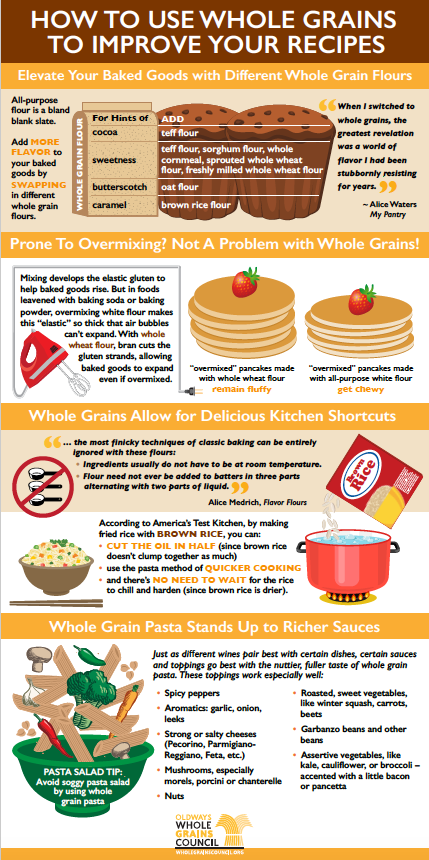Share This
Here at the Whole Grains Council, we field many questions from home bakers looking to use whole grain flour in their recipes. Here are a few quick tips to convert your favorite recipes to whole grain:
- In cookies, scones, pancakes, muffins, and quick breads (like banana bread), feel free to substitute whole grain flour for all-purpose flour one-to-one, without making other changes.
- In yeast breads that need to rise, feel free to substitute whole wheat flour for half of the all-purpose flour one-to-one, without making other changes.
- To make yeast breads 100% whole wheat, add an extra 2 teaspoons liquid per cup of whole wheat flour, and let the dough rest for 25 minutes before kneading.
- White whole wheat flour and fresh whole wheat flour (as opposed to flour that has been in your pantry for several months) tend to have the sweetest, mildest flavors.
- Work your way up slowly, gradually replacing more and more of the all-purpose flour with whole grain flour.
- For a sweeter flavor, replace 2-3 tablespoons of the liquid with orange juice.
To better understand the science of whole grain baking, we caught up with P.J. Hamel, of King Arthur Flour. Hamel has been with King Arthur for 25 years, and has authored (or co-authored) three King Arthur cookbooks, including the King Arthur Flour Whole Grain Baking Cookbook. This week I caught up with her to learn the best tips and tricks for baking with whole grains.
“The biggest challenge and the thing most people want to do is whole grain bread,” explains Hamel. Bakers can usually substitute up to 50% of the all-purpose flour in a recipe with whole wheat flour, without making other adjustments, and still enjoy a comparable taste and texture, “but if you go 100% [whole grain], you usually change the outcome.”
Fortunately, our baking expert has the solution. Hamel recommends an additional “two teaspoons of liquid per cup of whole wheat flour,” as whole grains tend to absorb more moisture. Additionally, she recommends allowing the dough to rest for about 20-25 minutes before kneading. Note that these tweaks are generally only necessary when replacing all of the white flour with whole wheat flour, but not if you’re just substituting half.
However, perhaps Hamel’s biggest secret weapon is the type of flour she uses: White whole wheat flour. White whole wheat flour isn’t bleached or refined. It is simply whole grain flour that has been milled from white wheat, rather than the more common red wheat. It has a lighter color and a milder flavor, but still offers all of the whole grain benefits, as its bran, germ, and endosperm are left intact. For this reason, white whole wheat flour is an excellent ingredient to use in whole grain baking, for breads, pastries, and everything in between.
As Hamel demonstrates, whole grain baked goods can be delicious and light, but bakers need to be aware that a hearty whole grain loaf will not taste identical to pillowy white bread. For this reason, Hamel warns that “people need to be sensible about what they can substitute.” She recommends that “everyone start by 50% [whole grain] and feel their way through.” Once they are comfortable, they can work their way up to a greater proportion of whole grains.
Additionally, some recipes better lend themselves to whole grain flour. In cookies, scones, muffins, and other baked goods that “aren’t stark white,” Hamel insists that you’ll “scarcely know the difference” when all-purpose flour is replaced with whole grain flour. Additionally, Hamel reveals that “banana bread is something that does really well with whole grains.” After all, “Everyone loves banana bread.” Similarly, muffins, chocolate cakes, and spice cakes are all well suited to whole wheat flour, due to their darker color and rich texture.
Another smart entry point into whole grain baking is to seek out recipes made specifically for whole grains. These recipes allow the nutty whole grain taste to shine, and are designed to showcase their pleasantly hearty texture. The most popular whole grain recipe from King Arthur is their Whole Wheat Waffles. According to Hamel, “you honestly cannot tell the difference” that these are made with 100% whole wheat flour. Other fan favorites that Hamel shares with us are the 100% whole grain Soft Chocolate Chip Cookies, and the Crazy Blonde Brownies (which use more than half whole grain flour).
While our conversation focused on whole wheat baking, Hamel reminds readers that both old fashioned and quick oats “are a great thing to bake with.” (Need proof? Try our Oat-y-Licious Wheat Bread or these Peanut Butter Chocolate Chip Oatmeal Cookies.) For the sweetest, most delicious taste, Hamel advises bakers to read the date on the label and “try to get fresh flour,” because “whole wheat flour does gradually oxidize.” (Note: this freshness is one of the many reasons that sprouted whole wheat flour is gaining popularity among bakers, including master baker Peter Reinhart). Lastly, for consumers seeking a milder product, or those who are new to the fuller, richer taste of whole grains, Hamel recommends replacing 2-3 tablespoons of the liquid in the recipe with orange juice, because it “helps temper the flavor of whole wheat.”
For more whole grain tips and tricks, check out our handy infographic below. (Kelly)




Comments
Add a Comment